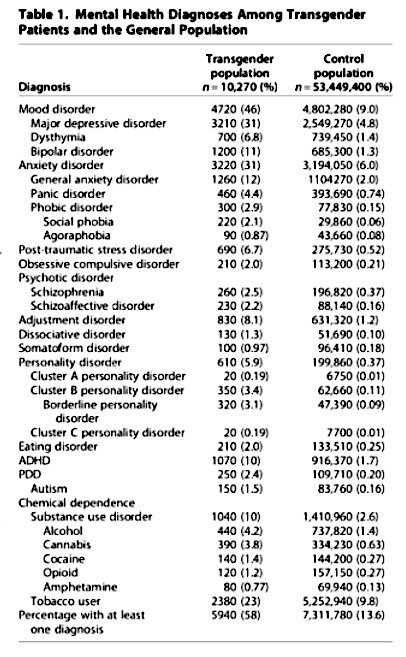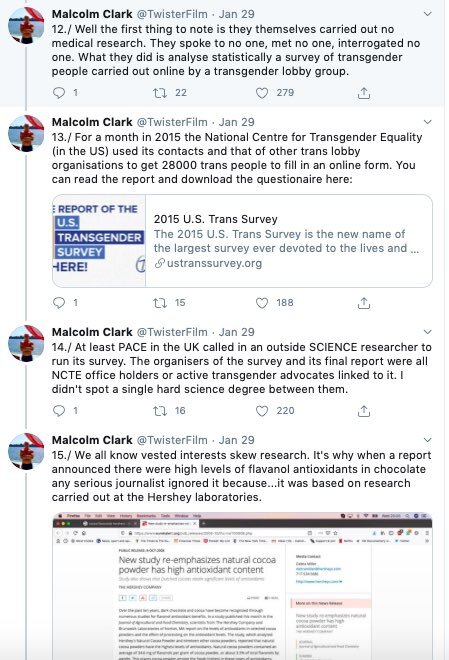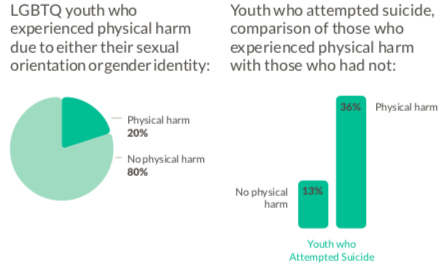News Commentary
Psychologist Ken Zucker has released a paper called “Adolescents with Gender Dysphoria: Reflections on Some Contemporary Clinical and Research Issues” discussing various issue around gender dysphoria covered on the GHQ website. These include the increase of natal females reporting they have gender dysphoria, suicidality, rapid onset gender dysphoria, and debates surrounding treatment.
Below is one quote regarding an explanation Zucker and other gender clinicians have for the increase of natal females identifying as trans or non-binary:
For example, per- haps behavioral masculinity (or behavioral “androgyny”) in birth-assigned females is subject to less social ostracism than behavioral femininity in birth-assigned males. If this conjecture is correct, then perhaps fewer birth-assigned males feel com- fortable coming out as transgender and, therefore, are less likely to present at specialized gender identity clinics. It is conceiva- ble, therefore, that, with further destigmatization, it will become easier for birth-assigned males to “come out” as transgender and the sex ratio will move closer to parity. Another possibility is related to the observation that gender-variant/gender noncon- forming behavior is more common in birth-assigned females than in birth-assigned males (from childhood onwards). If this is, in fact, the case, then it would imply that there would be a greater percentage of birth-assigned females at the “gender- atypical” side of the bell curve. In the contemporary era of increased destigmatization, perhaps more of these females are self-identifying as transgender or some other gender-variant self-identity and, as a result, more are presenting at specialized gender identity clinics.
There is a third and fourth possibility Zucker did not mention in this paragraph (although ROGD is mentioned later). The third is there are more females identifying as trans because of social contagion. There is historical evidence young females are prone to social contagions and body dysmorphia. The fourth is that same-sex attracted females and other “tomboys” in general are more prone to internalized homophobia or general insecurity about their gender. This is the opposite possibility Zucker mentions. It is that it is not socially acceptable to be a gender non-conforming girl or woman and this drives the transition, rather the social acceptability of being a trans-identified female. Some female desisters and detransitioners have cited anti-homosexual attitudes or fears around the treatment of females as part of the issues they had around their gender. This section reviews some of those statements, as well as a study that shows homophobic bullying increases trans identification.
Zucker discusses the sensitive topic of suicide risk in trans youth. Suicide risk is heavily promoted to enforce a view the affirmative model is the best mode of treatment. He has found that the suicide risk in gender dysphoric youth is about the same as the risk for any youth with any other mental health problem presenting for treatment:
Based on a variety of measurement approaches (e.g., standard- ized parent or self-report questionnaires, structured psychiatric diagnostic interview schedules, etc.), it has been found that adolescents referred for gender dysphoria have, on average, more behavioral and emotional problems than non-referred adolescents, but are more similar than different when compared to adolescents referred for other mental health concerns
He addresses the various explanations for the increased risk of suicidality:
There are several ways to conceptualize the elevated rate of co-occurring mental health issues among adolescents with gender dysphoria. In some instances, it may be that the gen- der dysphoria has emerged as secondary to another, more “primary” mental health diagnosis, such as autism spectrum disorder or borderline personality disorder, or as a result of a severe trauma (e.g., sexual abuse). Another explanation is that gender dysphoria is inherently distressing, i.e., the marked incongruence between one’s felt gender and somatic sex—even within psychosocial milieus that are largely “affirming/support- ive”—which leads to clinically significant symptoms such as anxiety or depression. A more common explanation (and one that is often favored by “gender-affirming” clinicians and theo- rists) is that the co-occurring mental health issues are simply secondary to factors such as family rejection or social ostracism within the peer group vis-à-vis the gender dysphoria (see, e.g., Grossman, Park, & Russell, 2016; Janssen & Leibowitz, 2018; McDermott, Hughes, & Rawlings, 2017).
In this section GHQ discusses the use of suicide terror in promotion of the affirmative model and how this discourse actually violates every suicide prevention groups policies on how suicide (which is socially contagious) should be discussed.
In this broader context of co-occurring mental health issues, concern about suicide risk has become a topic of intense focus in recent years (see, e.g., Tanis, 2016). On the Internet, for example, one might come across the comment made by some parents “I would rather have a trans kid than a dead kid” (see, e.g., Biggs, 2018; Digitale, 2017; “I’d Rather Have a Living Son Than a Dead Daughter,” 2016) and instances of completed suicide receive intense media scrutiny (e.g., Bever, 2016; Savva & Small, 2019). Indeed, Karasic and Ehrensaft (2015) asserted that completed suicides are “alarmingly high”—a statement which, in my view, has no formal and systematic empirical basis. In fact, I would argue that the statement itself is alarming.
He cites some studies that show support for the youth’s transition reduces suicide risk. GHQ also covers some of this information here.
From a treatment perspective, therefore, one can consider both non-specific and specific factors that might reduce the risk of suicidality. Regarding the latter, for example, it has been argued that (perceived) social support of an adolescent’s transgender identity reduces the risk of suicidality (Bauer, Scheim, Pyne, Travers, & Hammond, 2015). In another com- munity-based study, it was found that the number of social settings in which adolescents felt comfortable in using their preferred name was associated with less suicidal ideation and behavior (Russell, Pollitt, Li, & Grossman, 2018). Lastly, in a clinic-based study, Allen, Watson, Egan, and Moser (2019) reported that commencement of “gender-affirming” hormonal treatment was related to a decrease in self-reported suicidal feelings.
He discusses the issue of rapid onset gender dysphoria and the resistance to discourse around what could be causing it, sometimes by mental health and medical professionals even.
It is not entirely clear to me why some clinician and “armchair” critics have been so skeptical about the possible veridicality of ROGD. Perhaps because Littman (2018) advanced a set of hypotheses about predisposing psychosocial factors in its genesis, the objection is that this disrupts an essentialist model of gender dysphoria and, therefore, has therapeutic implications.
He also addresses the reality that some of the increasing numbers of young people coming out as trans are also desisting or detransitioning:
Because ROGD appears to be a new clinical phenome- non, we know very little about its subsequent developmental course, i.e., its “natural history.” For example, we know very little about rates of persistence versus desistance, which, in my view, is a critical issue in thinking about the applicabil- ity of the Dutch model with regard to the therapeutic care of these youth. At present, there are some compelling examples of desistance or even “detransition,” but right now this is largely in the form of individual testimony and parent’s report (see, e.g., “It’s not conversion therapy to learn to love your body: A teen desister tells her story,” 2017; Pique Resilience Project at https://www.piqueresproject.com/; Rae, 2017; Wil- liams, 2019). Thus, we urgently need systematic data on this point in order to inform best practice clinical care.
Since control groups are considered unethical he has some ideas about how to determine desistance overtime before the initiation of medical treatment:
Suppose, for example, an adolescent had to wait for a year, if not longer, to be seen for a baseline assessment. (Thus, they already have had time and space to continue to think about their gender identity, albeit without hormonal suppression and probably without ongoing psychosocial therapeutic support.) If one collected baseline data at the time of referral, and not the time of assessment, one could argue that if the adolescent continued to experi- ence gender dysphoria after sitting on a waiting list for a long time, this would, perhaps, be an argument for the institution of hormonal suppression. For those adolescents who, while on a wait-list, remitted with regard to their gender dysphoria, it is likely that they would not choose to even be seen for an assessment. Thus, one could use long wait-list times as a type of control as a partial way to evaluate the stability of the gender dysphoria.
Lastly, one could consider recommending exploratory psychosocial treatment without social transition and hormo- nal suppression, particularly if the case formulation is that the gender dysphoria has emerged in the context of other psy- chosocial factors or as a result of other mental health issues. Given the substantial uncertainties about best practice care for these youth, the frontline clinician will have to weigh carefully the benefits and risks of various treatment options and proceed with caution.
References:
Allen, L. R., Watson, L. B., Egan, A. M., & Moser, C. N. (2019). Suicidality and well-being among transgender youth after gender- affirming medical interventions. Clinical Practice in Pediatric Psychology. doi.org/10.1037/cpp0000288
Bauer, G. R., Scheim, A. I., Pyne, J., Travers, R., & Hammond, R. (2015). Intervenable factors associated with suicide risk in transgender persons: A respondent driven sampling study in Ontario, Canada. BMC Public Health, 15(525). doi. org/10.1186/s12889-015-1867-2.
Littman, L. (2018). Rapid-onset gender dysphoria in adolescents and young adults: A study of parental reports. PLOS ONE, 13(8). doi:10.1371/journal.pone.0202330
Russell, S. T., & Fish, J. N. (2016). Mental health in lesbian, gay, bisex- ual, and transgender (LGBT) youth. Annual Review of Clinical Psychology,12, 465–487. doi: 10.1146/annurev-clinpsy-021815-093153
Zucker, K. (2019). Adolescents with Gender Dysphoria: Reflections on Some Contemporary Clinical and Research Issues. Archives of Sexual Behavior doi.org/10.1007/s10508-019-01518-8












































